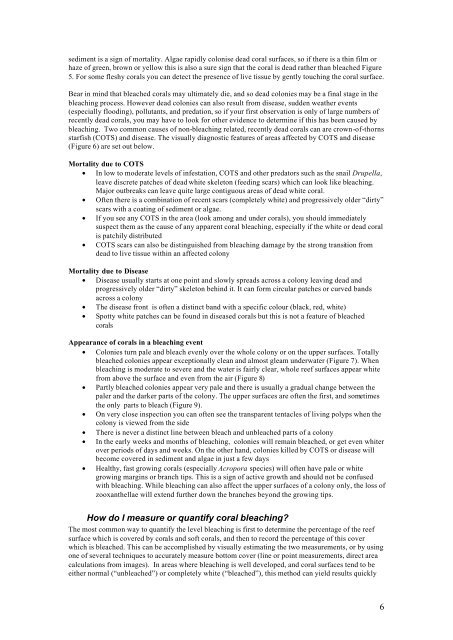Oliver et al (2004) Monitoring bleaching
Oliver et al (2004) Monitoring bleaching.pdf
Oliver et al (2004) Monitoring bleaching.pdf
Create successful ePaper yourself
Turn your PDF publications into a flip-book with our unique Google optimized e-Paper software.
sediment is a sign of mort<strong>al</strong>ity. Algae rapidly colonise dead cor<strong>al</strong> surfaces, so if there is a thin film or<br />
haze of green, brown or yellow this is <strong>al</strong>so a sure sign that the cor<strong>al</strong> is dead rather than bleached Figure<br />
5. For some fleshy cor<strong>al</strong>s you can d<strong>et</strong>ect the presence of live tissue by gently touching the cor<strong>al</strong> surface.<br />
Bear in mind that bleached cor<strong>al</strong>s may ultimately die, and so dead colonies may be a fin<strong>al</strong> stage in the<br />
<strong>bleaching</strong> process. However dead colonies can <strong>al</strong>so result from disease, sudden weather events<br />
(especi<strong>al</strong>ly flooding), pollutants, and predation, so if your first observation is only of large numbers of<br />
recently dead cor<strong>al</strong>s, you may have to look for other evidence to d<strong>et</strong>ermine if this has been caused by<br />
<strong>bleaching</strong>. Two common causes of non-<strong>bleaching</strong> related, recently dead cor<strong>al</strong>s can are crown-of-thorns<br />
starfish (COTS) and disease. The visu<strong>al</strong>ly diagnostic features of areas affected by COTS and disease<br />
(Figure 6) are s<strong>et</strong> out below.<br />
Mort<strong>al</strong>ity due to COTS<br />
• In low to moderate levels of infestation, COTS and other predators such as the snail Drupella,<br />
leave discr<strong>et</strong>e patches of dead white skel<strong>et</strong>on (feeding scars) which can look like <strong>bleaching</strong>.<br />
Major outbreaks can leave quite large contiguous areas of dead white cor<strong>al</strong>.<br />
• Often there is a combination of recent scars (compl<strong>et</strong>ely white) and progressively older “dirty”<br />
scars with a coating of sediment or <strong>al</strong>gae.<br />
• If you see any COTS in the area (look among and under cor<strong>al</strong>s), you should immediately<br />
suspect them as the cause of any apparent cor<strong>al</strong> <strong>bleaching</strong>, especi<strong>al</strong>ly if the white or dead cor<strong>al</strong><br />
is patchily distributed<br />
• COTS scars can <strong>al</strong>so be distinguished from <strong>bleaching</strong> damage by the strong transition from<br />
dead to live tissue within an affected colony<br />
Mort<strong>al</strong>ity due to Disease<br />
• Disease usu<strong>al</strong>ly starts at one point and slowly spreads across a colony leaving dead and<br />
progressively older “dirty” skel<strong>et</strong>on behind it. It can form circular patches or curved bands<br />
across a colony<br />
• The disease front is often a distinct band with a specific colour (black, red, white)<br />
• Spotty white patches can be found in diseased cor<strong>al</strong>s but this is not a feature of bleached<br />
cor<strong>al</strong>s<br />
Appearance of cor<strong>al</strong>s in a <strong>bleaching</strong> event<br />
• Colonies turn p<strong>al</strong>e and bleach evenly over the whole colony or on the upper surfaces. Tot<strong>al</strong>ly<br />
bleached colonies appear exception<strong>al</strong>ly clean and <strong>al</strong>most gleam underwater (Figure 7). When<br />
<strong>bleaching</strong> is moderate to severe and the water is fairly clear, whole reef surfaces appear white<br />
from above the surface and even from the air (Figure 8)<br />
• Partly bleached colonies appear very p<strong>al</strong>e and there is usu<strong>al</strong>ly a gradu<strong>al</strong> change b<strong>et</strong>ween the<br />
p<strong>al</strong>er and the darker parts of the colony. The upper surfaces are often the first, and som<strong>et</strong>imes<br />
the only parts to bleach (Figure 9).<br />
• On very close inspection you can often see the transparent tentacles of living polyps when the<br />
colony is viewed from the side<br />
• There is never a distinct line b<strong>et</strong>ween bleach and unbleached parts of a colony<br />
• In the early weeks and months of <strong>bleaching</strong>, colonies will remain bleached, or g<strong>et</strong> even whiter<br />
over periods of days and weeks. On the other hand, colonies killed by COTS or disease will<br />
become covered in sediment and <strong>al</strong>gae in just a few days<br />
• He<strong>al</strong>thy, fast growing cor<strong>al</strong>s (especi<strong>al</strong>ly Acropora species) will often have p<strong>al</strong>e or white<br />
growing margins or branch tips. This is a sign of active growth and should not be confused<br />
with <strong>bleaching</strong>. While <strong>bleaching</strong> can <strong>al</strong>so affect the upper surfaces of a colony only, the loss of<br />
zooxanthellae will extend further down the branches beyond the growing tips.<br />
How do I measure or quantify cor<strong>al</strong> <strong>bleaching</strong>?<br />
The most common way to quantify the level <strong>bleaching</strong> is first to d<strong>et</strong>ermine the percentage of the reef<br />
surface which is covered by cor<strong>al</strong>s and soft cor<strong>al</strong>s, and then to record the percentage of this cover<br />
which is bleached. This can be accomplished by visu<strong>al</strong>ly estimating the two measurements, or by using<br />
one of sever<strong>al</strong> techniques to accurately measure bottom cover (line or point measurements, direct area<br />
c<strong>al</strong>culations from images). In areas where <strong>bleaching</strong> is well developed, and cor<strong>al</strong> surfaces tend to be<br />
either norm<strong>al</strong> (“unbleached”) or compl<strong>et</strong>ely white (“bleached”), this m<strong>et</strong>hod can yield results quickly<br />
6


















